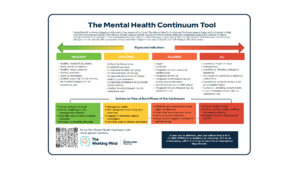Workplace stress isn’t just an unpleasant feeling at the end of a long workday. In Canada alone, it drains billions of dollars from the economy, fuels absenteeism, and chips away at employee work life balance.
What is workplace stress, and how does it affect employee mental health?
Workplace stress is the tension people feel when the demands of their job outstrip the time, control, or support they have to meet them. The most common causes of workplace-related stress are:
- Heavy workload and tight timelines
- Role confusion (stems from unclear or conflicting expectations)
- Low decision-making control (little say over how or when work is done)
- Poor workplace relationships (bullying, discrimination, weak supervisor support, toxic work environments)
- Job insecurity (contract work, layoffs, or tech displacement)
When these pressures last for weeks or months, they trigger a sustained “fight-or-flight” reaction that can lead to mental health issues such as anxiety, depression, high blood pressure, and sleep problems.
Why should employers care?
There’s plenty of evidence out there highlighting the importance of addressing mental health in the workplace. Some studies established a direct link between poor psychological health and safety standards and their impact on financial outcomes.
| Problem | Canadian evidence | Bottom-line impact |
| Presenteeism (working while unwell) | A 2024 study of 1,292 Canadian white-collar employees linked psychological distress to 143 lost work hours per person per year. (Costs of Presenteeism and Absenteeism Associated With… – LWW) | Hidden productivity loss and more errors |
| Absenteeism | StatsCan estimates 500,000 Canadians miss work in an average week for mental-health reasons. (Measuring workplace psychosocial factors in the federal government) | Overtime costs, schedule gaps, service delays |
| Turnover and intent to quit | A 2023 cross-sectional survey found burnout rates of 49 % in Canada’s public-health workforce; high-burnout staff were twice as likely to plan an exit. (Burnout among public health workers in Canada: a cross-sectional …) | Recruitment, onboarding, and lost know-how |
| Direct health costs | Canadian insurers report mental-health claims rising faster than all other benefits lines combined. | Higher premiums and disability payouts |
It is estimated that when taken together, all these problems result in more than $20 billion in losses each year.
Early warning signs
Expecting an employee to complain about workload is counterproductive. More often than not, if the complaint arises, it leaves little time to act. That’s why a manager needs to look for early warning signs.
- More short-notice sick calls—especially on Mondays and Fridays.
- After-hours email spikes—workers feel pressured to stay “always on.”
- Drop in voluntary ideas—people stop raising their hands in meetings.
- Higher conflict or HR complaints—stress shows up as irritability.
- Turnover in key roles—exit interviews citing “fit” or “balance.”
Addressing these flags early is far cheaper than waiting for a short- or long-term disability claim.
Made-in-Canada solutions
Several initiatives have been undertaken in recent years to help employers deal with the growing concerns over workplace mental health-related issues.
Canada leads the world with its National Standard for Psychological Health and Safety in the Workplace.
Three programs championed by the Mental Health Commission of Canada through its Opening Minds training division, put the Standard into action:
| Program | Goal | Value for employers |
| Mental Health First Aid | Provides the practical knowledge and skills to support to a person who may be experiencing a decline in their mental well-being, or a mental health or substance use crisis until professional help is available. | Creates a safety net before issues escalate. |
| The Working Mind | The Working Mind is a mental health training course designed to initiate a change in how you think, feel, and act about Mental Health. Provides tools and techniques to normalize conversations about mental health in the workplace | Normalizes conversation and reduces stigma. |
| Psychological Health & Safety Audit | Helps organizations take a comprehensive proactive approach to create a healthy, safe, and productive workplace where mental health initiatives are carefully planned, executed and measured. | Turns good intentions into measurable change. |
A growing body of research shows that implementing mental health training programs leads to consistent drops in mental health-related productivity issues, decreases self-stigma and boosts help-seeking behaviours among employees.
Key takeaways for Canadian leaders
- Stress is measurable and fixable. Track sick days, overtime, EAP usage, conduct regular surveys to detect early warning signs and take corrective actions when necessary.
- Training works. Programs like Mental Health First Aid and The Working Mind deliver ROI through fewer absences and stronger retention.
- Follow the Standard. Treat psychological safety with the same rigour as physical safety under the CSA Z1003 framework.
- Lead by example. When executives practice work-life balance and speak openly about mental health, employees believe they can too.
Workplace stress costs Canadian businesses dearly—but the tools to cut those costs already exist. By acting now, employers safeguard both their people and their productivity.


